What to do about the Cattlemen’s Beef Association’s imperial control over federal land-use policy in the West?
 From an essay by Christopher Ketchum in The American Prospect comes some acute observations about the power abuse in the face of common sense and at the expense of the public and the land:
From an essay by Christopher Ketchum in The American Prospect comes some acute observations about the power abuse in the face of common sense and at the expense of the public and the land:
“It’s almost a matter of religiosity that the real costs of ranching are paid for by the public,” says Brian Ertz, media director with the Western Watersheds Project. “Democratic and Republican congresspersons alike make their way up through political environments of extreme livestock–culture-dominated political organizations. The statehouses are dominated by livestock interests, and that’s where the federal representatives cut their teeth.”
The Cattlemen spend $2 billion to $3 billion is spent each year in state, federal, and county subsidies to support the survival of ranching on more than 250 million acres of land managed by the U.S. Forest Service and the Bureau of Land Management. With that money they have purchased their own predator extermination government agency, the federally funded wolf-killing unit, a branch of the U.S. Department of Agriculture (USDA) called Wildlife Services. Between the loss of predators and the damage done by grazing, they are slowly turning the West to dust:
The loss of “apex consumers” from ecosystems, says the report, “may be humankind’s most pervasive influence on nature.”
Ranching, by contrast, is considered one of the top causes of desertification, deforestation, and species extinction in the American West. An estimated 80 percent of the streams and riparian ecosystems in the West have been damaged by livestock grazing.
Even under a Democrat President, the Secretary of the Interior, Ken Salazar, a Colorado Democrat, comes from a family of five generations of ranchers. The public needs to put up a little more fuss about the management of their land by a destructive, subsidized, narrow special interest. We hope to provide some leadership at THP.








